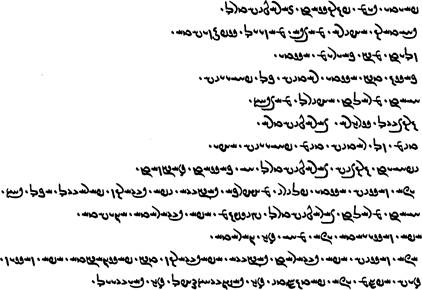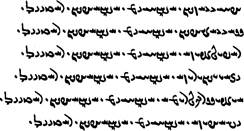THE SCRIPT AND THE TEXT Punctuation
In the manuscripts every word is separated by a point (period). The point is also regularly used to separate members of compounds (see Lesson 6), as well as to mark off preverbs and prefixes (not consistently), enclitic pronouns, sometimes even endings. The enclitic particles -ca and -cit, however, are not separated from the words they are attached to.
It has become tradition to transcribe this point by a period whenever it does not simply mark the end of a word. It is also sometimes used with enclitic pronouns (yä.më, etc.). This is wrong, however, as the long ê of the enclitic pronouns shows they were considered by the scribes as separate words. If they were genuinely enclitic, they would—by the rules (see below)—have final -e, not -ê, etc.
PHONOLOGY
Sound system. The a
The phonemic status of Avestan a is problematic. It is found mainly in the following phonetic contexts:
l. as the regular allophone of a before
nasals and before uu followed by i or i. Examples: hanti "they are"
(but zauuai¿zti "they curse"); maniiauuï-, feminine of maniiauua-
"belonging to the world of thought,' ![]() sauuišta-
"most rich in life-giving strength" (< sauu-), rauuï- f.
"fast," see below;
sauuišta-
"most rich in life-giving strength" (< sauu-), rauuï- f.
"fast," see below;
2. as the common anaptyctic vowel, see below.
Final syllables
Not all vowels, diphthongs, or consonants are found in final position.
Final vowels in monosyllables are always written long (except short -e in some late manuscripts), no matter their origins, e.g., mê "(to, for) me," zi "for, namely," nõ "(to, for) us."
The only diphthong found in final position is õi, and even
this is rare, e.g., yõi "who (plur.).'![]()
![]() In
polysyllabic words ä, i, 17, and diphthongs are not used at the end of words in
genuine Young Avestan, only in imitation of Old Avestan.
In
polysyllabic words ä, i, 17, and diphthongs are not used at the end of words in
genuine Young Avestan, only in imitation of Old Avestan.
Conspectus:
|
Finals: Short |
Monosyllables: |
Polysyllables: |
ä, i,
17, (5, d, a, ê, õi, äi, äu ![]()
Among the exceptions are: Araduuï Sura (possibly influenced by Pahl. Ardwïsür).
The diphthongs aê and ao become -(ii)e and -uuõ in final position. The diphthongs themselves reappear before -ca "and" and -cit "even": -aêca and -aoca, e.g., tê "they," taëcit "even they."
Note that vocative forms never take the enclitics -ca and -cit, and so the original diphthongs do not (usually) reappear in vocative forms.[1]
Few consonants are found as finals: the two
nasals m and n, the dental t and the sibilants s (rare), š (common), e.g.,
baranz "I carried," baran "they carried," barat "he
carried," hauruuatäs "wholeness, ![]() maniiuš
"spirit(s)," gairiš "mountain(s)."
maniiuš
"spirit(s)," gairiš "mountain(s)."
The consonant r always takes as supporting vowel when final, e.g., dätara "O creator! " ätara "O
2003
The consonant s takes a as supporting vowel when final in sandhi (see Lesson 4), e.g., kasa tê "who for
Vowels in monosyllables ending in consonants basically follow the same rules (or lack of rules) as vowels in other final syllables. In this introduction, short i will be used in words such as im "this (f.)" (not ïm), dim, diš.
Modifications of vowels: a + nasal
Among all the vowels, the vowel a is the most prone to change. Its main variants are a before uui/uuï and nasals (n and rn) and e when palatalized.
The variant a is in turn very sensitive to its surroundings and regularly becomes i when preceded by palatal consonants (ii, c, and j) and u when preceded by uu.
The combinations -(i)iim, -(u)uum and -(i)iin, -(u)uun are then finally simplified to -int, -um and -in, -un.
These finals in turn combine with a preceding -a- to form diphthongs: -aêm, -aom, etc.
Note: Sometimes the intermediate stage persists beside the final one, e.g., -aiian -aën.
The sound changes listed in the table below can all be derived from these rules.
Mastery of these rules and sound changes is crucial to the students' ability to analyze Avestan, as they pervade the entire language.
Following are some common examples of sound changes needed to understand the paradigms in this lesson. The student should learn them by heart. A complete table is given in lesson 7.
|
* -am |
|
|
|
|
*-an |
> |
-an |
|
|
|
*-iiam |
> |
-iiam |
|
|
|
> |
-iian |
> |
-in |
|
*-aiiam |
|
-aiiam |
> |
-aêm |
*-aiian |
> |
-aiian |
> |
-aên |
|
*-auuam |
|
*-auuam |
> |
-aom |
*-auuan |
> |
-auuan |
> |
-aon |

The voiced fricatives: p, (5, y
The voiced fricatives are all subject to contextual, possibly also dialectal, changes and variations.
Intervocalic (5 alternates with 9 in forms of vaëð- "to know" and the present stem daðä- of the verb dä"to give, place, create," e.g., vi9uš "knowing," da9at "gave."
Intervocalic p further tends to become uu, which in turn is subject to change, cf. aißi "to" > auui > aoi, viiäuuaitï- "shining far and wide" < *vi-ä-bä- < NIbä "to shine." The combination *bi became Pi, written ßii, which further became u! , which combined with preceding a > aoii, cf. *aôaßiia- "undeceivable": nom. a&zoiiõ, but acc. athuuinr, *daißï- f. "deceptive" > *daiuuï- (written daêuuï-, daëiuuï-).
The velar fricative y is lost in some positions: druuant-, cf. OAv. draguuant-; fem. rauuï- "fast" < rayu(cf. Skt. laghvï-); Mourum < *Maryum. 4
NOUNS u- and 17-stems
The endings of the nom. and voc. sing. and
plur. forms of the u- and ü-declensions and the irregular noun pasu-
"small cattle (sheep and goats)" are![]()
u-decl. pasu- ü-decl.
n.
nom. -uš -u -uš -uš
voc. -uuõ
![]()
4
See Skjærvø, "Avestica Il,'' 1997.
9, 2003
nom.-voc. -auuõ, -auuas -u -uuÕ, -UUaS -uuõ, -uuaso
Paradigms (ratu- m. "(divine) model," pouru- "much, many," tanü- f. "body," pasu- m. "sheep"; note how the labialization rules work!):
|
|
u-decl. |
|
n. |
pasu- |
ü-declen,sion |
|
|
f. |
|
|||||
|
nom. voc. |
ratuš ratuuõ |
pouruš
|
pouru |
pasuš |
tanuš |
|
|
nom.-voc. |
|
ratauuõ, |
parauuö, |
pouru |
pasuuõ |
tanuuõ |
|
|
|
ratauuas0 |
parauuas0 |
|
pasuuas0 |
tanuuaso |
Notes:
In the manuscripts we often find pasuuõ "normalized" to pasauuõ.
ratu- is properly a u2-stem (see Lesson I l).
For the feminine u-stems, see ao-stems in Lesson 8.
The vocative endings of the i-stems (and aë-stems): -e (< *-!e), and u-stems: -uuõ, are for *-aë and *-ao in final position.
After ii the vocative ending is only -õ: maniiõ < maniiu- "spirit," Vaiiõ < Vaiiu-.
About the endings
The a-, i-, and Il-declensions originally in Indo-European) had the same ending in the nominative singular, namely -s, as in Greek e€ós theós "god," TTL'(JTLS pístis "faith" and ikhthús "fish," Latin dominus, civis, sinus, but in the Indo-Iranian mother language s became h after a and ä but š after i or u according to the "ruki" rule, which states that s became sl after r, u, k [Iran. x], i). The Indo-Iranian forms were therefore * -ah, *-iš, *-uš.
In addition, in Avestan final *-h was lost causing rounding of the preceding vowels: *-ah > -õ, *-äh > -å.
ADJECTIVES
Feminine and neuter forms
Feminine forms of adjectives of the a-declension are usually declined according to the ä-declension, occasionally according to the ï-declension, e.g., sura- "rich in life-giving strength," f. surä-; spmgta- "lifegiving," f. spantä-, but zaranaëna- "made of gold," f. zaranaëinï-, maniiauua-, f. maniiauuï-.
Note the fem. nom. sing. naire < *nairiia of nairiiä-
"manly, heroic.'![]()
Feminine forms of other adjectives are
declined according to the ï-declension, e.g.: vaohu- "good,' ![]() vaì'hï-
f.; pouru- "plentiful, many," paoirï- f.; driyu- "poor,"
driuuï- f. (note the phonetic changes).
vaì'hï-
f.; pouru- "plentiful, many," paoirï- f.; driyu- "poor,"
driuuï- f. (note the phonetic changes).
Neuter adjectives are declined like neuter nouns, e.g., nom.-acc. sing. suram, ähuiri "belonging to/related to Ahura (Mazdã)," vohu.
Adjectival compounds in -ïand -17
There are a few adjectival compounds ending in root nouns in -ï and -17, e.g., yauuaëjï- "living forever" and yauuaêsü- "vitalized forever" (see Lesson 12: laryngeal stems). These stems are declined like ü-stems, but few forms are actually attested:
2()()3
 äat
jasat Zaraeuštrõ "Then came Zarathustra.
äat
jasat Zaraeuštrõ "Then came Zarathustra. 

